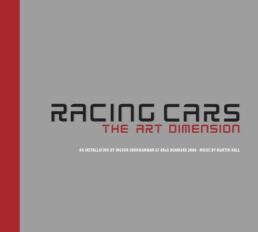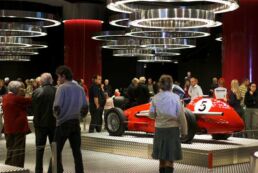RACING CARS
MARTIN HALL
CD
OCTOBER 2006
PANOPTIKON (OPTIK 08)
From the 13th of October until the 30th of December 2006 the Danish art museum Aros became the home for the high-profile exhibition Racing Cars – The Art Dimension by internationally renowned artist Ingvar Cronhammar.
With this world premiere of the unique meeting between art and racing cars Aros wanted to focus on the sculptural and aesthetic dimensions of the cars, dimensions which were emphasized in the artistic presentation: an enormous installation of Formula 1 and Le Mans racing cars.
Housing the installation of Formula 1 and Le Mans racing cars meant that the museum’s guests became subject to a remarkable experience at the exhibition, an installation that covered all of the 1.400 square metres of the museum’s special exhibition space and foyer.
By regarding racing cars not just as functional items, but also as pure form – as sculpture on wheels – the exhibition created a symbiosis between two widely differing worlds: between the ultimate motor sport and art. The exhibited racing cars were not only unique in their design forms, they had also seen active service on racetracks the world over with such legendary drivers as Stirling Moss, Ronni Petersson and Jackie Stewart behind the wheel. In a ground-breaking presentation guests were introduced to a unique universe where the walls had been painted black, the floor had been covered by reflecting steel plates, the gallery columns had become red, metallic pistons, and the lights had been turned into giant piston rings. The racing cars were presented on steel podiums in an installation of light, sound and moving images.
As the finishing touch a unique soundscape was composed for the event by Martin Hall. Presenting an entirely new, 77-minute long composition concurrently released on cd Hall once again worked with The Vista Dome Ensemble as well as the choir Konsort and singer Katja Andersson. Hall also added countertenor Michael Morelli who performs on four sequences of the work’s 45 musical chapters. On the cd, however, the work remains one coherent piece of work due to the overall impression of the exhibition itself.
Racing Cars – The Art Dimension still represents ARoS’ most visited exhibition so far. More than 10.000 people made it to the museum in the opening days alone. Altogether the exhibition was seen by 137.000.
“We know that cars of this type are driven with the body and that you feel and steer the car with your entire body. Against the background of the organic unity of driver and car that we experience in Formula 1 in action, the absence of the driver in the exhibition becomes yet more striking. In ordinary cars you sit behind the steering wheel, but in present-day Formula 1 cars the driver is fitted into the speed machine like a larva in its cocoon. When, on stopping, the driver pulls himself out of the car or is pulled out by a team hurrying to help, the effect is one of an amputation or a culinary act that could be carried out with a lobster fork.
The car is left like an empty shell. This has an effect all the more powerful as a result of the erotic connotations that have always been associated with the most powerful racing cars. Suspended during the race, the drivers fling their cars from side to side in staccato, writhing, zigzag movements. The purpose is to keep the tires warm. But sitting in the tightly enclosing car, with only his head sticking up, it appears as if the driver turns himself and the car into a dildo. The driver’s motor function and the car’s reactions are coordinated; the organ extension lives and obeys. In contrast to the raised driving position formerly occupied by drivers, a position in which they seemed both heroic and individually recognisable, drivers today are not only anonymous, but packed inside the entire organism of the car.
The most powerful expression of triumph in the winning driver, which is only caught by the close-up camera in the car, consists of a thumbs up sign or a clenched fist. The absence of the driver in the exhibition imposes a limit to the public, but is also acts as a spooky deficiency, an anatomical void.”
Excerpt from the catalogue written by professor at The Royal Danish Academy of Fine Art (Schools of Architecture, Design and Conservation) Carsten Thau, autumn 2006.


